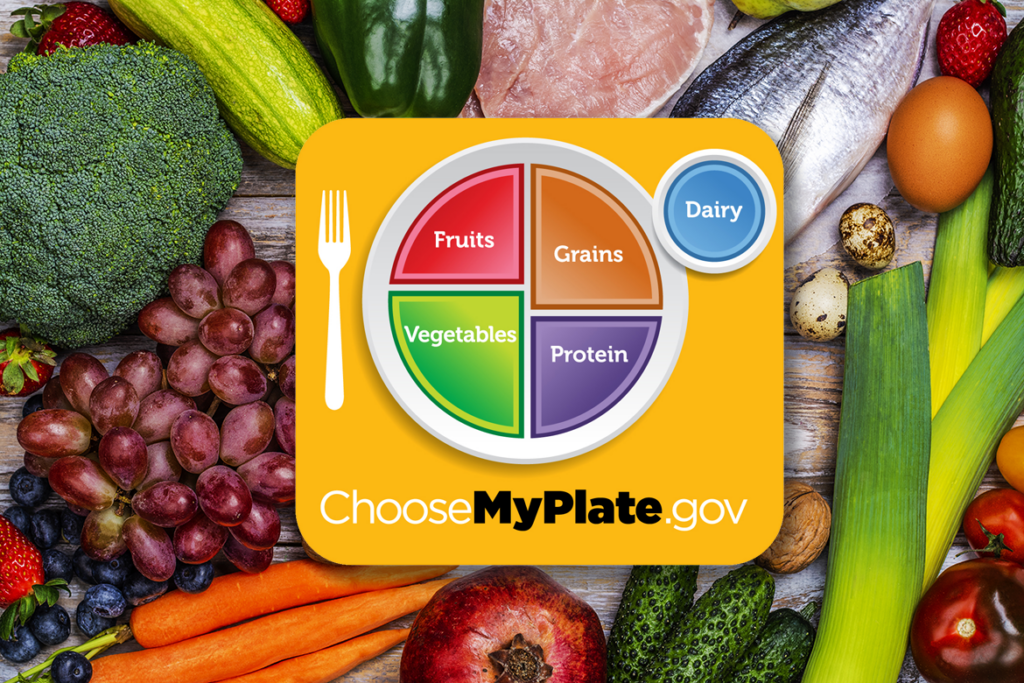Build healthy meals using MyPlate guidelines

BY KAITLYN WEBB, MS, RDN
For many of us, diet and nutrition can be confusing. Add in a chronic condition like high blood pressure or diabetes, common conditions for many older adults, and you may be completely lost on what to eat and drink.
You may be an older adult who has gotten several different recommendations from health care professionals, television or internet celebrities and family members on which diet is the best, which will improve your labs, which will make you feel better, etc. It can be confusing. In fact, if you followed ALL those diet recommendations, you might be left with very little to eat. That certainly would not be nourishing to your body.
So, what is the “healthy” diet for an older adult?
Popular diets are often about restriction or limiting “bad foods” to improve your health, but take a step back and try a different approach. Remember, food is what nourishes us, food is what provides us with energy, and food is what keeps us strong and able-bodied. In fact, excess restriction can often lead to malnutrition or unintended weight loss, especially in frail older adults. Research shows that eating a variety of foods at each meal and snack is often the best option.
When building a plate, refer to the MyPlate diagram. Note that the 8-inch plate is comprised of:
- ½ fruits and vegetables
- ¼ whole grains
- ¼ protein
- a serving of dairy
Let’s practice. Think about your next meal. Do you have veggies, a low-fat dairy, a whole fruit, a lean protein and a whole grain?
If not, before you build your plate, think about some smart alternatives to help match the MyPlate guide. For example, if I’m planning on having a hamburger, french fries and soda for dinner, I must pause and consider which food groups I’m missing out on and simply make a switch. In this example, I’m missing out on veggies, fruits, dairy and whole grains. An excellent switch would be coleslaw or salad and 1 cup of watermelon instead of french fries, a glass of milk instead of a soda, or a whole grain hamburger bun in place of a regular bun. If I make all three switches, I have added a serving each of vegetables, dairy and whole grains. I’ve also decreased my intake of sodium, saturated fat and total calories just by thinking about MyPlate.
While older adults do not need to eat a different diet than the rest of the family, the focus should be on several nutrients to ensure adequate intake.
CALORIES
Older adults often need fewer calories than when they were younger. So enjoy all your favorite foods, but focus on the portion sizes shown on the MyPlate diagram. Check out these tips to keep calories at goal:
- Use an 8-inch round plate and a small bowl during meals.
- Make foods that are high in saturated fat and calories, like pizza, cheese, sausage, biscuits, hot dogs, and certain desserts occasional options rather than everyday choices.
- When eating out, choose options that include vegetables, fruits and whole grains. When served a large portion, take home half and save for a later meal.
- Eat from home more often.
FOCUS ON PROTEIN & PHYSICAL ACTIVITY
Choose a variety of protein sources daily and aim to include a serving at each meal. If you have difficulty chewing meats, opt for well-cooked soft lean meats, seafood, beans, nut butters and eggs.
Combine your protein intake with physical activity to maintain your muscle mass. Pick activities you enjoy, like swimming, gardening or going for walks. Gradually increase activity as tolerated.
FRUITS, VEGGIES & WHOLE GRAINS
Most adults do not eat enough fruits, vegetables and whole grains on a daily basis. By referencing the MyPlate guide at mealtimes, you can easily meet your nutrition needs for these groups. Older adults should choose a variety of vegetables, but focus on dark-green, orange and red veggies as well as legumes (beans and peas). Frozen fruits and veggies are often an easy-to-prepare and affordable option.
When choosing grains, look for 100 percent whole grain on bread, crackers, cereal, brown rice, and pasta packaging.
FLUIDS
As we get older, our thirst sensation often decreases, which puts us at risk for dehydration. Drink plenty of water and low-fat milk throughout the day and choose hydrating foods like fruits, vegetables and soups. When reading the nutrition label, smart fluid choices will be lower in added sugar and contain no high fructose corn syrup.
Disclaimer: The MyPlate model was designed by the United States Department of Agriculture and reflects the Dietary Guidelines for Americans to meet the nutrient needs of most Americans. If you have special dietary needs, please consult with your medical provider or a Registered Dietitian. Visit choosemyplate.gov for additional information on MyPlate and for recipe ideas.
– Kaitlynn Webb is a Registered Dietitian Nutritionist at Mountain Empire PACE. She earned a Master’s in Science in Clinical Nutrition from East Tennessee State University.
Get Updates From MEOC
Categories
MEOC Newsletter
April 2022 Stepping Stones - April 2022 Stepping Stones
February 2022 Stepping Stones - February 2022 Stepping Stones